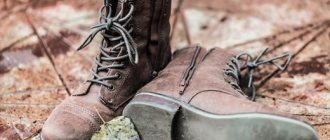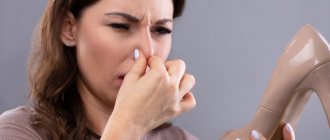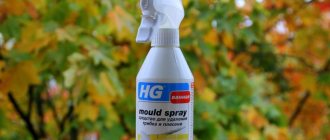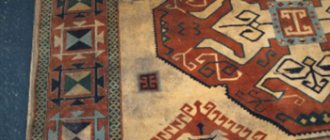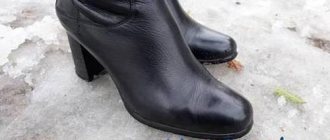Mold is an unpleasant but private surprise. It appears from improper storage, constant humidity, and “infection” of shoes from each other. Mold is a fungus and is also dangerous to humans. Spores easily contaminate surrounding surfaces, penetrate the respiratory tract and remain on the skin, causing diseases. We will look at options on how to remove mold from shoes so as not to throw away a pair. Treatment is necessary not only to restore the appearance, but also, above all, for sanitation.
Causes of mold in shoes
Mold on shoes in the house can develop in two ways:
- if there is already a mold mycelium in the house, then during the development of spores (microscopic “seeds”) are carried by air currents, penetrating into the smallest cracks;
- spores or part of the mycelium could remain on the shoes after visiting the street, forest, or room contaminated with mold fungi.
Mold is often found on shoes made from natural materials:
- leather;
- suede;
- textile.
Mold on shoes
However, mold does not hesitate to settle on shoes made of leatherette or other synthetic materials.
If boots or dress shoes are moldy, most likely there is a suitable microclimate in the room:
- high humidity;
- uneven heat distribution;
- improper ventilation.
In general, if shoes become moldy during storage, we can conclude that they were not cleaned properly:
- the shoes were poorly washed and not cleaned (not cleaned enough);
- remained under-dried (wet);
- was stored without access to fresh air (in a tight plastic bag, in a closed box, box).
Where does mushroom mycelium come from?
Particularly annoying is mold found on holiday or weekend shoes while you are getting ready for a celebration. Having opened the treasured box, you suddenly feel an unusual, unpleasant smell, and then notice accumulations of a fluffy substance at the joints of the seams and on the decorative details.
Some of those who find themselves in a similar situation quickly get out of the awkward situation. Having used anti-fungal shoe spray, they quickly solve problems with their appearance and, closing the topic, go to the planned event, without thinking about where the threads of pathogenic mycelium come from.
More prudent citizens do not remove the issue of mold from the agenda. Because if it appears in a shoe closet, it means that the mycelium is already living in the house and, if you miss the moment, the mold will quickly and imperceptibly capture the entire living space and begin to take away the vitality of the household.
We recommend reading: Why is mold dangerous to your health? (What damage can it cause).
How to remove mold?
First, you should carefully examine the affected shoes. Mycelium destroys organic matter, and if shoes have been in a moldy state for a long time, it is easier to get rid of them than to take measures to resuscitate them and remove the fungus.
Among the options for how to get rid of mold on shoes, there may be several solutions. The most important measure in this fight is to get rid of dampness in the house, which provokes the growth of pathogenic microflora. You can also recommend finding and getting rid of mold myceliums that can infect not only shoes.
If the product label indicates that it can be washed, this may be a solution in a situation where it is necessary to remove mold or stains that remain from it, as well as an unpleasant musty smell. Usually you can wash sneakers, sneakers, textile or knitted shoes. It is better to use the delicate wash mode without spinning in the machine, or do it manually.
Chemicals
Modern chemical compositions will help get rid of stains, dirt, streaks and mold. Sometimes they may contain aggressive substances. Therefore, before you start removing mold from shoes, make sure that the composition will not wash off the paint or varnish. Test the product in an inconspicuous place.
Liquid disinfectants such as:
- Alaminol;
- Amiksan;
- Diabak;
- Desihead;
- Stopplesen
will remove mold from shoes and destroy spores. First, the product is sprayed, allowed to penetrate deep inside, then the shoes are washed or washed.
You can treat shoes with antifungal agents. The scheme is similar to that described above. Suitable for these purposes:
- Mycostop;
- Bitsin;
- Dezavid;
- Lamitel.
Mycostop
Alcohol antiseptics are used in the same way. Suitable pharmaceutical products:
- chlorhexidine;
- formycin;
- acetic anhydride;
- ammonia;
- hydrogen peroxide.
Chlorine-containing products will also help get rid of mold:
- White;
- Domestos;
- Sarma.
Traditional methods
Moldy shoes can be cleaned with available home remedies that were used before the invention of antiseptics. Several options for removing mold using traditional methods:
- Vodka or medical alcohol will help get rid of plaque. Moisten a rag or cotton swab with liquid and gently wipe the damaged areas. Then leave until completely dry. Do not use tinctures of herbs or fruits; they may stain your shoes.
- A solution of table vinegar and clean water in a 1:1 ratio is used in the same way.
- For dark (black) shoes, you can take a solution of potassium permanganate.
- Grate 100 g of laundry soap and dilute with very hot water to a gel consistency. Apply the resulting mixture with a brush. This method will help if your shoes are very moldy.
Shoe care rules
A number of simple preventive measures will prevent the appearance of mold and dampness in shoes and keep them in good condition for a long time.
- Regular drying after wearing in inclement weather and washing shoe insoles.
- Daily use of professional care products with regular wear, incl. having water-repellent and antiseptic effects.
- Daily change of hosiery, which accumulates moisture during sweating and becomes a favorable environment for the appearance and development of fungus.
- Proper preparation for storage. Shoes that have not been used for a long time. Do not dry boots and shoes on the radiator. This is a simple and quick drying method, but it causes damage to the material. Ultraviolet light is a good assistant in drying and disinfection. The lamps not only dry shoes and eliminate their unpleasant odor, but also rid the interior space of pathogenic microorganisms that cause skin diseases.
- Proper storage. Shoes must be kept in cardboard boxes, inside of which there are bags with moisture-absorbing granules placed in them by the manufacturer. It is recommended to place paper tightly inside the closed shoe. Plastic bags are not suitable for storage.
Eliminating odor
The damp smell from shoes may remain even if they are thoroughly washed and disinfected. Using inexpensive household products will help you quickly and effectively remove the smell of mold from your favorite shoes. Use:
- tea soda (sodium bicarbonate);
- coarse salt;
- ground coffee (you can take “used” tea leaves);
- tea bags (you can also take dried tea bags, as long as they are dry);
- crushed activated carbon tablets.
Tea bags
Pour the powder inside the shoes and leave for a day. Then shake out thoroughly and vacuum up any remaining residue. The use of sorbents will help to effectively remove the smell of mold from any shoes.
Attention! Soda and salt cannot be used for food after this.
Sometimes it is enough to leave the couple for several days in the fresh air for ventilation, for example, in the shade on the balcony, and the smell will disappear by itself.
An alternative to solar heat is deep freezing. Place the shoes (clean, in a canvas bag) in the freezer overnight (or longer). If shoe processing is done in winter, boots can be taken out to the balcony (at the same time).
Getting rid of cat urine odor
It is quite difficult to remove the smell of cat urine at home. It is better if the treatment is carried out immediately.
You won't be able to simply air out shoes that have gotten cat urine on them.
The damaged item is processed in several stages:
- Initially, it is washed in warm soapy water, thereby removing the cat’s urine, which he used to mark shoes or boots;
- remove traces of the main component - urochrome - using vinegar essence with a concentration of 9%, after diluting it with water in a 1:1 ratio, thoroughly wiping the surfaces inside and out;
- at the third stage, they get rid of uric acid, which stinks of spoiled things - they do this by first applying soda slurry, and after washing it off with water, glycerin;
- wash the shoes again and dry them in the open air.
How to prevent mold on shoes in the future?
Simple preventive measures will help protect shoes, both made of genuine leather and other materials.
- Moisture is the main enemy of shoes. The pair should be dried every time you take off your shoes. This must be done especially carefully when it is removed for long-term seasonal storage. Shoes should be dried at room temperature; high temperatures may cause warping and deformation. To remove moisture faster, shoes can be stuffed with crumpled newspapers, constantly changing them. Modern dryers use gentle heat (quartz radiation).
- It is strictly not recommended to store shoes in tight bags or boxes without ventilation. Small holes in shoe boxes are just for ventilation. Don't throw away the boxes you brought your new pair home in; they will also come in handy for seasonal storage. Linen bags are also suitable.
- Silica gel is the optimal solution for maintaining the required level of humidity. Small beads are dried polysilicic acid gel. The bags have practically no expiration date.
Attention! Make sure that children and pets do not swallow the silica gel beads.
- Have your shoes inspected periodically.
- Ultraviolet light will destroy pathogenic fungi on shoes. To do this, it is enough to leave the couple in the shade, without access to direct sunlight.
- Inspect the insoles regularly, wash and disinfect them as necessary, and throw away the used ones.
- Do not wear shoes on wet feet, change socks or tights daily, and maintain personal hygiene. Don't let strangers wear your shoes. In the store, try on shoes only on the toe (toe) to prevent infection with fungal diseases of the skin and nails, which can also cause the spread of mold in shoes. For sweating, use deodorants (talc, powders) and special creams.
- Disinfect the interior surfaces of the cabinet. Suitable for this:
- 1% chlorhexidine solution;
- 15% formidron;
- Miramistin spray is suitable for treating shelves, boxes, the inside of shoes, insoles, and laces.
Professional products
Shoe care products contain antibacterial substances that eliminate odors, speed up drying, leave no stains after treatment and increase the service life of shoes.
Deodorants
Available in the form of sprays, sticks and tablets. They are often used not only when treating shoes, but also when deodorizing the feet - the space between the toes, the tops of the feet and soles.
- Sprays . The treatment is carried out after thoroughly shaking the container by spraying at a distance of 20 cm from the surface and for 2-3 seconds. It is better to carry out internal processing in advance, with the expectation of drying.
- Sticks. Intended for daily use by applying to the inner surface of shoes.
- Pills. This is an innovative deodorizing method designed for athletes. The tablets contain components that kill bacteria and fungi. They are placed inside and left for 5-6 hours.
Powders
Shoe powders have disinfecting and flavoring properties and at the same time reduce foot sweating. The products are poured into shoes.
Absorbent bags
Shoe sachets and pillows filled with bamboo charcoal powder act as absorbents and disinfectants, absorbing moisture and odors. They are placed in shoes between uses.
Why is mold dangerous for humans?
Mold spores affect people through direct skin contact and the respiratory system. They are toxic and multiply quickly, and when they enter the body, they cause serious illness. With prolonged exposure, damage to the liver and kidneys and the development of pulmonary emphysema are possible. But even short-term exposure to mold has an adverse effect on people’s well-being. They appear:
- allergic dermatitis, fungal skin infections, mycoses;
- dizziness and frequent pain;
- digestive disorders;
- various diseases of the upper respiratory tract - sinusitis, cough, runny nose, asthma;
- exhaustion of the body.
People with weakened immune systems (the elderly, those who have suffered serious illnesses, after taking antibiotics or a course of chemotherapy) and children are most susceptible to the effects of mold.
Dampness - how to deal with it
An unpleasant, “basement” musty smell can be eliminated in the following ways:
To prevent mold from bothering you: fungus prevention
It is enough to follow a few simple storage rules during the off-season:
- Dry your shoes well before packing them away for long periods of time..
- Instead of plastic bags, it is advisable to use special fabric bags or cardboard boxes.
- Treat the inside of shoes with antifungal sprays or antiseptic solutions before long-term storage.
- Provide ventilation or periodically remove shoes to air them out.
- Place small bags of silica gel in your shoes. This substance absorbs moisture. Where can I get them? First of all, don’t throw it away after buying a new pair and some other things. A small amount of gel cat litter in a gauze bag will also work.
The problem of mold is relevant for many people. This is not a reason to throw away your favorite pair. The main thing is to properly clean and disinfect your shoes. After this, you can wear it without fear.



